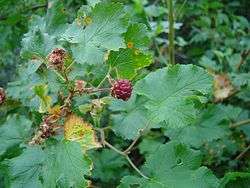Rubus deliciosus
| Rubus deliciosus | |
|---|---|
 | |
| Cultivated in Sweden | |
| Scientific classification | |
| Kingdom: | Plantae |
| (unranked): | Angiosperms |
| (unranked): | Eudicots |
| (unranked): | Rosids |
| Order: | Rosales |
| Family: | Rosaceae |
| Genus: | Rubus |
| Species: | R. deliciosus |
| Binomial name | |
| Rubus deliciosus Torr. 1827 | |
| Synonyms[1] | |
| |
Rubus deliciosus, the delicious raspberry,[2] boulder raspberry,[3] Rocky Mountain raspberry[4] or snowy bramble,[5] is a North American species of flowering plant in the rose family, native to the United States, in the Rocky Mountains in Colorado, New Mexico, the Oklahoma Panhandle, and Wyoming. There are also reports of isolated populations in the Texas Panhandle and in the Black Hills of South Dakota.[6]
Habitats
Rubus deliciosus inhabits scrub and rocky slopes.[7][8][9]

Description
Rubus deliciosus is a deciduous shrub or vine growing to 1.5 m (5 ft), rarely 3 m (10 ft), with arching stems. Unlike many species of Rubus, the flowering stems are perennial. The bark is flaky and peeling. The leaves are simple (not compound, like most other species in the genus), 3.3–5 cm long and broad, with three shallowly rounded lobes (occasionally unlobed or five-lobed), becoming glabrous beneath. The flowers are 3.8–6 cm diameter, fragrant, with five white petals 1.5–3 cm across.
The fruit is dark red, 10–13 mm diameter; it is rather dry and not highly valued, but the flavor is said to be delicious.[8][10][11] The wild forms generally have unappealing fruit.[12]
Cultivation
Rubus deliciosus requires well drained soil in full sun. It is hardy to USDA zone #5 (-20°F; -29°C). It is propagated by cuttings in July or August.[11]
Hybrids
Rubus deliciosus has been hybridized in cultivation with the very closely related (and possibly conspecific) Rubus trilobus of southern Mexico. This hybrid was introduced by the English plant collector Collingwood Ingram as R. × tridel (Flowering bramble). It is popular as an ornamental plant in gardens, having larger flowers up to 8 cm diameter.[13]
The cultivar R. × tridel 'Benenden' has gained the Royal Horticultural Society's Award of Garden Merit.[14]
References
- ↑ The Plant List, Rubus deliciosus Torr.
- ↑ "Rubus deliciosus". Natural Resources Conservation Service PLANTS Database. USDA. Retrieved 25 October 2015.
- ↑ Robertson, L.; Squires, D.B.; Association, R.M.N. (1999), Southern Rocky Mountain Wildflowers: A Field Guide to Common Wildflowers, Shrubs, and Trees, Falcon, ISBN 9781560446248
- ↑ "BSBI List 2007". Botanical Society of Britain and Ireland. Archived from the original (xls) on 2015-02-25. Retrieved 2014-10-17.
- ↑ Lavallée, A. (1880), "Rubus deliciosus", The Garden, 17: 48–48
- ↑ Biota of North America Program 2014 county distribution map
- ↑ USDA Plants Profile: Rubus deliciosus
- 1 2 Oklahoma Biological Survey: Rubus deliciosus
- ↑ Weber, W.A. & Wittmann, R.C. 1992. Catalog of the Colorado flora: a biodiversity baseline. University of Colorado Press, Niwot, Co. The Colorado Catalog - Online Version
- ↑ Rocky Mountain Native Plants Company: Rubus deliciosus
- 1 2 Phillips. R. & Rix. M. (1989). Shrubs. Pan Books ISBN 978-0-330-30258-6.
- ↑ Weber, W.A. 1976. Rocky Mountain flora: A field guide for the identification of the Ferns, Conifers, and Flowering Plants of the Southern Rocky Mountains from Pikes Peak to Rocky Mountain National Park and from the Plains to the Continental Divide. University Press of Colorado, Niwot, CO.
- ↑ National Museums Northern Ireland: Ornamental Bramble
- ↑ "RHS Plant Selector - Rubus 'Benenden'". Retrieved 31 May 2013.